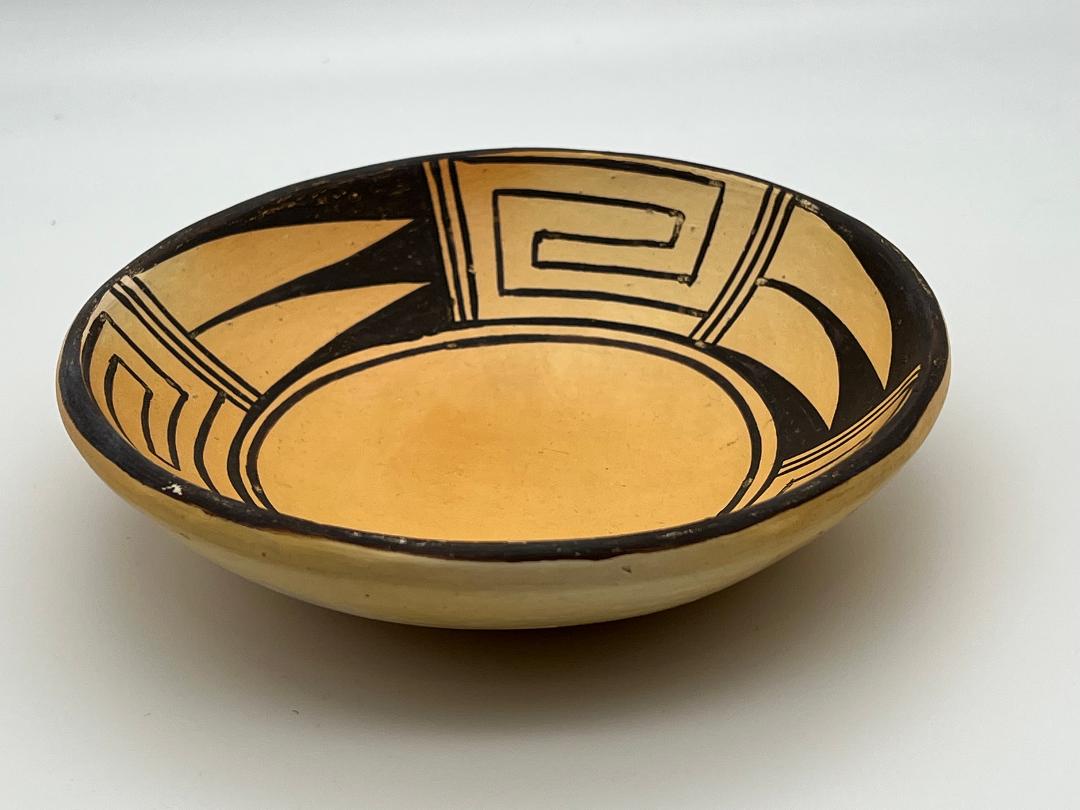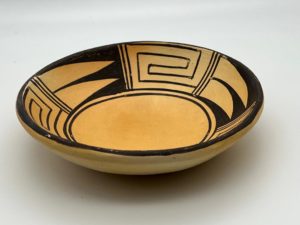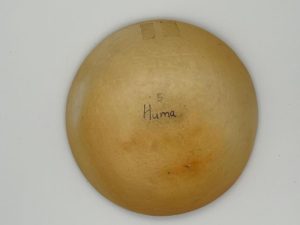This is an ordinary, somewhat scratched, shallow dish with a simple design by “Huma,” presumably either Rosetta, Stella or Violet.
It is, however, a clear example of an ancient pueblo design strategy called “isomeric design” (Ortman and Traugott, 2018) that is still a mainstay of modern Hopi and Hopi-Tewa pottery, a technique which Lydia Wyckoff calls ““figure-ground reversal” (1985:94-103). Thus this dish is included in the collection as an instructive example of this optically vibrant design technique
Form:
The bowl has a flat bottom and sides that gently sweep upward to the rim. The walls are even and a bit thick for a pot of this small size. There is slight blushing from the outdoor dung fire, especially on the exterior surface,
Design:
The exterior of the bowl is not painted.
The rim of the bowl is painted black. The lower edge of the interior design band is based on a circular framing line. Below it runs a parallel second circular framing line. The variation in space between these two circles indicates that the artist had good, but not exceptional, control of her yucca paint brush.
The interior design displays two designs alternately. three times each. The six segments of design are separated by perpendicular spaces within which are pained three parallel lines that are anchored on the framing line below and the rim above. These three lines form “two-lane highways,” a conventional Hopi and Hopi-Tewa device for creating borders between design segments.
Design #1:
This design is a simple linear crook formed by bending a single line into eight 90-degree turns. The upper line grows out of the two-lane highway to the left of the design and is close and parallel to the painted rim. Eight turns later the lower edge of the crook, parallel but some distance from the upper framing line, joins the right highway.
Design #2:
This design is formed of three modified black isosceles triangles that grow out of a common base that is flat against the right three-lane highway. The central triangle is shown in full, but the upper and lower triangles are only 50% present, the lost half obliterated by either the top rim or a bottom framing line. The tips of the three triangles touch the far left three-lane highway, thus bridging the full width of the segment.
Perceptual trickery:
Both designs display “figure-ground reversal reversal” (Wyckoff), what Ortman and Traugot call “isomers.”
Lydia Wyckoff has a simple description of this strategy: “when you look at the pot the figure and the background against which it is placed keep changing places, the figure becomes the background and the background becoming the figure” (1985:100 and 94-103).
Ortman and Traugott examine ancient pottery and discuss theories of perception to explain four strategies for manipulating the appearance of design (2018:27-37). The strategy used on bowl 2020-06 they call “painted-and-unpainted isomers” and note that it “may be the most difficult designs to create but (is) perhaps the easiest to understand” of the four strategies:
“With this design strategy the artists painted shapes that simultaneously left similar, unpainted reciprocal forms that produced dynamic optical reversals. The motifs appear as painted figures against unpainted backgrounds but also as unpainted shapes in front of painted grounds. A sophisticated organizational structure is required to produce isoimetric pairs by this reciprocal method…
It would be difficult –virtually impossible– to paint such a design without first producing an organizational grid to establish the spacing and produce motifs based on equal pairs of pronged elements….
To most present day viewers the painted elements of a painted-and-unpainted design first appear as positive forms spatially situated in front of an unpainted background…But….the unpainted shapes also can be perceived as the intended image and appear as a figure floating spatially in front of a hachured background….(T)he organizational grid produced an equal division of space, creating ambiguous figure-ground relationships (2018:29-31).”
Such visual trickery can most easily be seen on bowl 2020-06 in the panels containing the three isosceles triangles. Obviously the three left-pointing black triangles are the design that is painted on the unpainted clay surface, and this is what the eye sees first. The residual unpainted surface, however, forms two right-pointing triangles, and on second look these seem to be the dominant images set against a black background. First you see one pattern, then you see the other. The viewer’s eye is unsettled, and flips back and forth between these two perceptions, enlivening the design. The elements of design could not be more simple but the placement of the elements in space is sophisticated and excites the eye.
The same strategy is followed in the panel containing the crook, though seeing it requires a more-studied focus. While the design is created from one continuous line, it can alternatively be seen as two interlocking crooks, the same pattern you create when you interlock the bent fingers of your two hands. As before, the viewer’s eyes search for pattern and the ambiguity of the design enlivens the perception. This interlocking crook was believed by Alexander Steven to represent “water wrought into a meandering device” (Patterson, 1994:241), which may refer to the blessing of running water or the place of emergence in the Grand Canyon. Such interpretation may be an artifact of early Figure-ground reversal designs appear frequently on Hopi and Hopi-Tewa pottery.
For examples of Nampeyo’s use of the device, see figure-ground reversal in Appendix F. Generally only a subset of designs on a pot use this technique to spice up the overall painting. Dish 2020-06 is an unusual case since all of its simple designs employ the device. As such it presents an instructive opportunity and thus is included in this collection.




